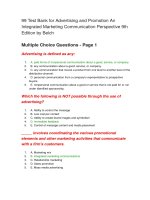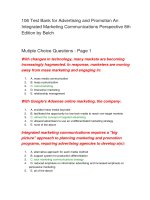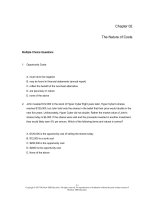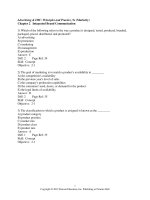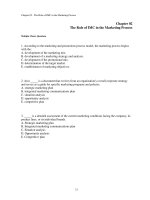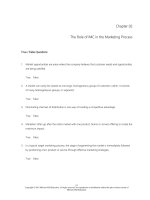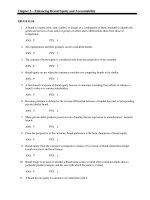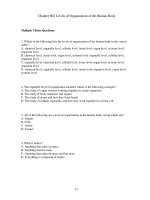Advertising and promotion an integrated marketing communications perspective 9th edition belch test bank
Bạn đang xem bản rút gọn của tài liệu. Xem và tải ngay bản đầy đủ của tài liệu tại đây (337.67 KB, 81 trang )
Chapter 02 - The Role of IMC in the Marketing Process
Chapter 02
The Role of IMC in the Marketing Process
Multiple Choice Questions
1. According to the marketing and promotions process model, the marketing process begins
with the:
A. development of the marketing mix.
B. development of a marketing strategy and analysis.
C. development of the promotional mix.
D. determination of the target market.
E. establishment of marketing objectives.
2. A(n) _____ is a document that evolves from an organization's overall corporate strategy
and serves as a guide for specific marketing programs and policies.
A. strategic marketing plan
B. integrated marketing communications plan
C. situation analysis
D. opportunity analysis
E. competitive plan
3. _____ is a detailed assessment of the current marketing conditions facing the company, its
product lines, or its individual brands.
A. Strategic marketing plan
B. Integrated marketing communications plan
C. Situation analysis
D. Opportunity analysis
E. Competitive plan
2-1
Chapter 02 - The Role of IMC in the Marketing Process
4. _____ are defined as external areas where there are favorable demand trends, customer
needs and wants are not being satisfied, and where a company thinks it can compete
effectively.
A. Market opportunities
B. Market segments
C. Competitive advantages
D. Market strengths
E. Market plans
5. To reach tweens (8-12 year olds), Jell-O brand gelatin marketers introduced X-treme Jell-O
in wild berry, green apple, and watermelon flavors. The ads describe the gelatin flavors as
"Jell-O with an attitude" because these fruit flavors "will bite you back." Jell-O has defined
tweens as:
A. part of an undifferentiated market.
B. aggregated market.
C. a response-stimulus market.
D. the mass market for gelatin.
E. a market segment.
6. China is the world's second-largest beer market after the U.S. It is also one of the fastest
growing with annual growth of 10 percent. Anheuser-Busch responded to this _____ in China
when it established Budweiser Wulhan International Brewing in central China. There it brews
Budweiser and Budweiser Ice which are sold to the local market.
A. market opportunity
B. market aggregation
C. competitive advantage
D. market strength
E. market threat
2-2
Chapter 02 - The Role of IMC in the Marketing Process
7. Anyone who has ever attended a state fair understands how complicated the ticketing
system can be. Attendees buy a number of tickets and then turn them in to various ride
operators. One ride may require three tickets, another five, and another two. The system was
complicated for workers and for consumers. A company named Funtastic has developed a
SmartCard that is purchased at the ticket booth for any amount customers want to spend. Each
ride requires one swipe of the card, and the amount of the ride is deducted electronically from
the card's total. Funtastic has recognized a:
A. market opportunity.
B. market segment.
C. competitive advantage.
D. market strength.
E. market threat.
8. There are many different types of medicines for relieving allergy symptoms, and there are
several that offer 24-hour relief, but only Alavert comes in a quick-dissolving form that can
be easily swallowed without water. The maker of Alavert hopes the fact that it dissolves and
enters the system more quickly than other brands will create a:
A. market aggregation.
B. market segment.
C. competitive advantage.
D. market strength.
E. market threat.
9. Offering quality products that command a premium price, providing superior customer
service, having the lowest production costs and lower prices etc. are ways of:
A. achieving competitive advantage.
B. market segmentation.
C. mass marketing.
D. exploiting market opportunity.
E. undifferentiated marketing.
2-3
Chapter 02 - The Role of IMC in the Marketing Process
10. _____ is something unique or special a firm possesses or does that gives it an edge over its
competitors.
A. Brand quality
B. Brand equity
C. A competitive advantage
D. Brand power
E. A market opportunity
11. Today many people take an aspirin at their doctor's recommendation as preventive
medicine. The maker of Bayer aspirin has added calcium to its aspirin. The calcium is also
often recommended by doctors to help maintain bone density. There are many types of aspirin
on the market, but only one brand that contains calcium. For Bayer, this calcium additive is an
example of:
A. brand quality.
B. brand equity.
C. a competitive advantage.
D. brand power.
E. a market opportunity.
12. The first step in the target marketing process is to:
Refer: Figure 2-2
A. develop positioning strategies.
B. request government approval.
C. determine whether to use a market segmentation strategy or a mass marketing strategy.
D. identify markets with unfulfilled needs.
E. develop new products.
13. The market segmentation process:
A. divides a market into distinct groups that have heterogeneous needs.
B. divides a market into distinct groups that will respond similarly to marketing actions.
C. offers one version of the product to all markets.
D. identifies markets with unfulfilled needs.
E. positions products in the minds of prospects and customers.
2-4
Chapter 02 - The Role of IMC in the Marketing Process
14. Directing a company's efforts towards one or more groups of customers who share
common needs is known as:
A. target marketing.
B. competitive advantage.
C. positioning.
D. market segmentation.
E. branding.
15. Dividing the market into units such as nation, states, town, counties etc. is known as:
A. demographic segmentation.
B. psychographic segmentation.
C. quantified aggregation.
D. lifestyle aggregation.
E. geographic segmentation.
16. Which of the following is a geographic variable for segmentation of the market?
A. Family size
B. Occasions
C. Cities
D. Age
E. Gender
17. Geographic segmentation is about dividing:
A. consumers based on lifestyle.
B. markets based on location.
C. consumers based on usage.
D. consumers based on income.
E. markets based on benefit the product has to offer.
2-5
Chapter 02 - The Role of IMC in the Marketing Process
18. Ramen has recently come up with instant soup packets which it advertises in the colder
regions of Asia and Europe. This is an example of:
A. demographic segmentation.
B. psychographic segmentation.
C. sociocultural segmentation.
D. geographic segmentation.
E. undifferentiated marketing.
19. Bubba's Frozen Barbecue Sandwiches contain pork drenched with a vinegar-based
barbecue sauce. It would not be popular in Texas where barbecue lovers want goat meat, or in
the Carolinas where a mustard-based sauce is preferred. Given this information, Bubba's
should use _____ segmentation.
A. demographic
B. buying condition
C. personality
D. geographic
E. behavioristic
20. General Foods' determination that Southerners preferred milder mustard than those in the
Northeast led the company to develop a new "Southern Style Mustard." This strategy best
exemplifies:
A. geographic segmentation.
B. lifestyle segmentation.
C. concentrated marketing.
D. usage segmentation.
E. undifferentiated marketing.
2-6
Chapter 02 - The Role of IMC in the Marketing Process
21. When retail buyers told the people who sold Duck Tape brand duct tape that tweens and
teens were significant purchasers of the tape and used it to repair skateboards and other
extreme sports equipment, the makers of Duck Tape introduced duct tape in wild neon colors
specifically for this market because research showed this market liked fun colors. By targeting
tweens and teens that skateboard and engage in other extreme sports, the maker of Duck Tape
used _____ segmentation.
A. geographic
B. sociocultural
C. behavioristic
D. socioeconomic
E. demographic
22. Division of the market based on age, sex, family size, income, and other measurable
characteristics is known as:
A. demographic segmentation.
B. psychographic segmentation.
C. quantified aggregation.
D. lifestyle aggregation.
E. undifferentiated marketing.
23. An ad for Shangri-La Travel Agency offers trips especially designed for grandparents and
their grandchildren to enjoy together. This example illustrates the use of _____ segmentation.
A. geographic
B. demographic
C. lifestyle
D. behavioristic
E. personality
24. Ads for consumer finance companies are often aimed at people making annual salaries of
$25,000 or less. Consumer finance companies are using _____ segmentation.
A. geographic
B. demographic
C. lifestyle
D. behavioristic
E. personality
2-7
Chapter 02 - The Role of IMC in the Marketing Process
25. Kyle wrote a book for new dads to help them take care of the babies when the wives are
away. It is highly recommended that Kyle employ _____ to divide the market.
A. geographic segmentation
B. demographic segmentation
C. psychographic segmentation
D. socio economic segmentation
E. cultural segmentation
26. Dividing the market on the basis of personality and/or lifestyles is referred to as _____.
A. geographic segmentation
B. demographic segmentation
C. psychographic segmentation
D. socio economic segmentation
E. behavioural segmentation
27. Gatorade sports drink has defined its target market as 18-34 year old males who are active
in sports. Which two bases of segmentation is Gatorade employing?
A. Benefit and demographic
B. Psychographic and geographic
C. Demographic and psychographic
D. Geographic and benefit
E. Benefit and psychographic
28. _____ divides a market on the basis of lifestyles.
A. Leisure marketing
B. Psychographic segmentation
C. Benefit segmentation
D. Demographic segmentation
E. Behavioristic segmentation
2-8
Chapter 02 - The Role of IMC in the Marketing Process
29. Company X is a non-profit organization, that employs a large number of underprivileged
people. It sells art and handicrafts made by these individuals at reasonable prices. Company X
defines its market segment as people who believe in helping others and feel good about it. It
uses _____ segmentation.
A. demographic
B. geographic
C. psychographic
D. benefit
E. socio economic
30. AIO stands for:
A. activities, innovation and opinions.
B. activities, interests and opportunities.
C. activities, innovations and opportunities.
D. activities, interests and opinions.
E. actions, interests and opinions.
31. An ad for Nivea Visage Wrinkle Control states that the cream allows women to "give their
skin back its own wrinkle control." It shows a woman in her forties using the product. This ad
is using _____ segmentation.
A. behavioristic and benefit
B. benefit and demographic
C. psychographic and behavioristic
D. geographic and benefit
E. demographic and psychographic
32. Crest has come up with three types of toothpastes for different segments - whitening
toothpaste for individuals who buy for aesthetic reasons, strawberry-flavored toothpaste for
those concerned with the taste, and germi-check toothpaste for those looking to protect their
teeth all day long. On what basis has it segmented the market?
A. Demographic
B. Geographic
C. Socio economic
D. Benefit
E. Socio cultural
2-9
Chapter 02 - The Role of IMC in the Marketing Process
33. Crossings is the name of a book club designed to appeal to conservative Christians. It sells
inspirational fiction and nonfiction books that express moral values consistent with the views
of these Christians. Crossings uses _____ segmentation.
A. psychographic
B. demographic
C. behavioristic
D. usage
E. geographic
34. The ad for the Disney Institute at Walt Disney World describes vacations during which an
individual can immerse him or herself in the joys of gardening for a week and take classes
with horticulturists. This is an example of _____ segmentation.
A. psychographic
B. demographic
C. behavioristic
D. usage
E. geographic
35. _____ segmentation divides consumers into groups according to their usage, loyalties, or
buying responses to a product.
A. Benefit
B. Geographic
C. Demographic
D. Behavioristic
E. Psychographic
36. Research shows that about two-thirds of the new insurance policies Prudential sells will be
to current policyholders. This information indicates a(n) ______ segmentation would be
appropriate for Prudential to use along with demographic and psychographic segmentation.
A. benefit
B. geographic
C. SRI
D. behavioristic
E. VALS
2-10
Chapter 02 - The Role of IMC in the Marketing Process
37. New York Telephone uses _____ segmentation to segment consumers in terms of how
much leisure telephone calling they do. It advertises on "Nick at Night" and MTV when it
wishes to target the group it calls "chatterboxes."
A. behavioristic
B. benefit
C. demographic
D. geographic
E. VALS
38. Which of the following bases for segmentation is employed when consumers are grouped
according to their use of a product or service (heavy versus light)?
A. Behavioristic
B. Demographic
C. Benefit
D. Lifestyle
E. Psychographic
39. Degree of usage as a basis of segmentation is best reflected by:
A. demographic segmentation variables.
B. the iceberg principle.
C. the benefit rule.
D. the rule of equity.
E. the 80-20 rule.
40. _____ segmentation is most closely related to the "80-20 rule," which states that 80
percent of a company's business comes from 20 percent of its customers.
A. Geographic
B. Behavioristic
C. Demographic
D. Psychographic
E. Benefit
2-11
Chapter 02 - The Role of IMC in the Marketing Process
41. The 80-20 rule states that:
A. around 80 percent of the firm's sales comes from 20 percent of the customers.
B. only 80 percent of a market can be segmented.
C. market segmentation works well only 80 percent of the time.
D. only about 80 percent of the people remember the firm's positioning of a product while the
remaining 20 percent create their own positioning for a particular product.
E. about 80 percent of corporations do not understand the actual meaning of the term "market
segmentation".
42. _____ segmentation is the grouping of customers on the basis of attributes sought in a
product.
A. Benefit
B. Geographic
C. VALS
D. Demographic
E. Lifestyle
43. An advertising campaign stating that BMW "outperforms most cars on the road even
before you step on the accelerator" is an example of _____ segmentation.
A. benefit
B. demographic
C. geographic
D. VALS
E. SRI
44. The ad for Tempur-Pedic's weight control mattress describes the mattress as "a perfect
refuge from the cares of the day." This description indicates that the mattress maker is using
_____ segmentation to define its market.
A. benefit
B. demographic
C. geographic
D. behavioristic
E. SRI
2-12
Chapter 02 - The Role of IMC in the Marketing Process
45. The fact that some consumers want pure bottled water while some want flavored bottle
water and still others want bottled water with added minerals provides an opportunity for
_____ segmentation in the bottled water market.
A. behavioristic
B. benefit
C. geographic
D. psychographic
E. demographic
46. Volvo's strategy of emphasizing the safety of its cars in their advertising reflects a
positioning strategy based on:
A. benefit segmentation.
B. demographic segmentation.
C. psychographic segmentation.
D. positioning by competitor.
E. positioning by product class.
47. _____ involves ignoring segment differences and offering just one product or service for
the entire market.
A. Marketing mix
B. Positioning
C. Concentrated marketing
D. Synchro marketing
E. Undifferentiated marketing
48. When Coca-Cola only had one product in its line and was targeting everyone, the
company was employing:
A. concentrated marketing.
B. undifferentiated marketing.
C. market atomization.
D. niche marketing.
E. benefit segmentation.
2-13
Chapter 02 - The Role of IMC in the Marketing Process
49. When MetaboLife first came on the market, its only product was a weight-loss pill that
was guaranteed to energize the user by causing a greater level of physical activity, which
would help in burning calories. This was its only product, and it was marketed to anyone who
wanted to lose weight or have more energy. This means, that its target market was virtually
anyone breathing because very few people like their current weight, and everyone could use a
little more energy. MetaboLife used:
A. concentrated marketing.
B. undifferentiated marketing.
C. market atomization.
D. niche marketing.
E. demographic segmentation.
50. _____ involves developing separate marketing strategies for a number of segments.
A. Differentiated marketing
B. Undifferentiated marketing
C. Concentrated marketing
D. Behavioristic segmentation
E. Geographic segmentation
51. L'Oreal, the giant cosmetics manufacturer, targets the luxury market with Helena
Rubinstein and Lancôme brands. Its less expensive brands like Elseve and L'Oreal are sold by
discount retailers. L'Oreal uses:
A. concentrated marketing.
B. undifferentiated marketing.
C. market atomization.
D. synchro marketing.
E. differentiating marketing.
52. Coca-Cola's offerings of diet, cherry-flavored, vanilla-flavored, and caffeine-free versions
of its product in addition to its original product reflect the company's decision to serve:
A. concentrated markets.
B. differentiated markets.
C. a demographic segment.
D. an undifferentiated market.
E. geographic segmentation.
2-14
Chapter 02 - The Role of IMC in the Marketing Process
53. _____ is used when the firm selects one segment and attempts to capture a large share of
this market.
A. Positioning
B. Undifferentiated marketing
C. Concentrated marketing
D. Differentiated marketing
E. Branding
54. Concentrated marketing is based around focusing marketing efforts on:
A. different countries.
B. one particular segment.
C. mass market.
D. a number of segments.
E. a particular country.
55. Astrid Furniture designs and sells bedroom furniture for people who are over six-feet tall
which is a relatively small target market. Astrid is employing which targeting strategy?
A. Differentiated marketing
B. Synchro marketing
C. Undifferentiated marketing
D. Concentrated marketing
E. Mass marketing
56. "Thirteen percent of all American males are shorter than 5'6". A retail store that sells
exclusively to men of this size is using:
A. market aggregation.
B. undifferentiated marketing.
C. concentrated marketing.
D. market atomization.
E. demographic segmentation.
2-15
Chapter 02 - The Role of IMC in the Marketing Process
57. When Bruce Teilhaber opened his men's shoe store, he decided to carry a full line of shoes
in the larger, hard-to-find sizes. Today, his shoe store caters to professional basketball,
baseball, and football players who appreciate the variety and quality of shoes Tielhaber
carries and often order a dozen new pairs in a single visit. This shoe store uses:
A. market aggregation.
B. undifferentiated marketing.
C. concentrated marketing.
D. market atomization.
E. demographic segmentation.
58. When Rolls Royce attempts to capture a large market share of the $300,000 car buying
market and only that market, it is an example of:
A. market aggregation.
B. undifferentiated marketing.
C. concentrated marketing.
D. market atomization.
E. demographic segmentation.
59. _____ is defined as the art and science of fitting the product or service to one or more
segments of the broad market in such a way as to set it meaningfully apart from competition.
A. Target marketing
B. Benefit segmentation
C. Undifferentiated marketing
D. Demographic segmentation
E. Positioning
60. Product positioning is about:
A. the perception of a product from the view of competitors.
B. the position of the product on the shelf of a retail store.
C. the way the product is packed.
D. developing a perception about a product or service in the mind of the consumers.
E. shelf life of a product.
2-16
Chapter 02 - The Role of IMC in the Marketing Process
61. A brand's market position refers to its:
A. relative market share.
B. location on store shelves.
C. image in the mind of the customers.
D. distribution intensity.
E. stage in the product life cycle.
62. _____ is the process of building a brand whereas _____ is about putting the brand in the
mind of the customer.
A. Positioning; branding
B. Branding; positioning
C. Marketing; positioning
D. Targeting; branding
E. Segmenting; positioning
63. BMW's positioning of its convertible as "the ultimate tanning machine" would reflect a
positioning strategy based on:
A. product attributes and benefits.
B. cultural symbols.
C. product user.
D. price/quality.
E. competitors.
64. The headline on the ad for Broilmaster Grill read, "The Most Durable Grill Known to
Man." Broilmaster is using a positioning strategy based on:
A. product class.
B. product attributes and benefits.
C. price/quality.
D. competitor.
E. cultural symbol.
2-17
Chapter 02 - The Role of IMC in the Marketing Process
65. Isopure positions itself as a zero-carb muscle recovery drink. Isopure is using a _____
positioning strategy.
A. product class
B. product attributes and benefits
C. price/quality
D. competitor
E. cultural symbol
66. United Parcel Service (UPS) built its advertising campaign around the slogan, "moving at
the speed of business." This slogan was an example of a positioning strategy based on:
A. cultural symbols.
B. demographics.
C. price-value.
D. product attribute and benefit.
E. competitor.
67. The manufacturer of Mercedes-Benz autos stressed that the car had side door air bags in
an attempt to attract new buyers. Its focus on safety illustrated a strategy of positioning by:
A. cultural symbols.
B. demographics.
C. price-value.
D. product attribute and benefit.
E. competitor.
68. Wal-Mart has been very effective in positioning itself as a store that offers quality
products at a very good price. Their strategy reflects positioning based on:
A. benefit segmentation.
B. demographic segmentation.
C. psychographic segmentation.
D. price/quality.
E. product class.
2-18
Chapter 02 - The Role of IMC in the Marketing Process
69. McDonald's Big &Tasty burger was advertised as a juicy quarter-pounder with lettuce,
tomatoes, and all the trimmings that can be purchased for $1 from McDonald's Dollar Menu.
The Big & Tasty burger and other items on the Dollar Menu are positioning by:
A. competitor.
B. demographics.
C. product user.
D. price/quality.
E. product class.
70. Campbell's ads contain quick and easy recipes that can be made using Campbell's soups.
This is an example of positioning by:
A. product class.
B. product use.
C. price/quality.
D. competitor.
E. cultural symbol.
71. The Florida Orange Juice Commission's advertising campaign based around the slogan,
"It's not just for breakfast anymore," reflected positioning by:
A. product user.
B. use or application.
C. product class.
D. competitor.
E. cultural symbol.
72. Athletic shoes advertised for tennis courts, running, or for walking are using positioning
based on:
A. price/quality.
B. use or application.
C. product class.
D. product user.
E. cultural symbols.
2-19
Chapter 02 - The Role of IMC in the Marketing Process
73. To encourage more people to use mass transit, ads from metropolitan transportation
services compare the ease and comfort of riding mass transit with the difficulties of congested
traffic and parking headaches. These urban bus and subway services are using positioning by:
A. product class.
B. product user.
C. price/quality.
D. product attributes.
E. cultural symbols.
74. Digital cameras, computers, and high-quality printers are allowing people to take and
process their photographs. An owner of a film-processing store could advertise the benefits of
professional photograph finishing when compared to printer copies, which will fade over
time. The film-processing store could use positioning by:
A. product class.
B. product demographics.
C. product user.
D. competitor.
E. cultural symbol.
75. When Bruce Teilhaber opened his men's shoe store, he decided to carry a full line of shoes
in the larger, hard-to-find sizes. Today, his shoe store caters to professional basketball,
baseball, and football players who appreciate the variety and quality of shoes Tielhaber
carries and often order a dozen new pairs in a single visit. The shoe store uses positioning by:
A. product demographics.
B. cultural symbols.
C. product user.
D. competition.
E. product class.
2-20
Chapter 02 - The Role of IMC in the Marketing Process
76. An ad for Gaylord shorts found in Runner's World magazine shows how the shorts do not
bind and are made of a light fabric that helps keep the wearer dry and cool. Gaylord is using
positioning by:
A. product user.
B. product demographics.
C. cultural symbol.
D. product class.
E. distribution intensity.
77. Which of the following would constitute a positioning strategy focusing on the
competitor?
A. BMW—"The Ultimate Driving Machine"
B. Red Roof Inns—"Equal Value at a Lower Price"
C. Oneida flatware—"Your Table Is Ready"
D. Coca-Cola—"The Real Thing"
E. Broilmaster grill—"The Most Durable Grill Known to Man"
78. Progresso soup positioned itself as better tasting and more appropriate to the adult palate
to gain a competitive advantage over Campbell's soup. Progresso used positioning by:
A. product attributes.
B. cultural symbols.
C. competitor.
D. product user.
E. product class.
79. The use of comparative advertising has become more and more common. Which of the
following positioning strategies does this reflect?
A. Positioning by product user
B. Positioning by product class
C. Positioning by competitor
D. Positioning by price/quality
E. Positioning by cultural symbol
2-21
Chapter 02 - The Role of IMC in the Marketing Process
80. When many frequent travelers think of Australian-based Quantas Airlines, the first thing
that comes to mind is the koala bear. Because of this strong association, Quantas is receiving
the benefit of positioning by:
A. product class.
B. use/application.
C. cultural symbol.
D. product attribute.
E. competitor.
81. The use of the gecko lizard in the Geico Direct insurance company commercials indicates
a positioning strategy based on:
A. price/quality.
B. use or application.
C. cultural symbol.
D. product class.
E. distribution intensity.
82. _____ involves altering or changing a product's or brand's position.
A. Market segmentation
B. Market targeting
C. Positioning.
D. Target marketing
E. Repositioning
83. _____ is often difficult to accomplish due to previously entrenched attitudes toward the
product or brand.
A. Positioning by cultural symbols
B. Positioning by price/quality
C. Positioning by product attributes
D. Repositioning
E. Positioning by product user
2-22
Chapter 02 - The Role of IMC in the Marketing Process
84. Unisys Corporation engaged in a multi-million dollar campaign to alter its perceptions
among many of its customers that it was simply a hardware manufacturer. Unisys wants
customers to see it as a services and technology provider. Unisys was:
A. using a repositioning strategy.
B. segmenting the market in new, more profitable ways.
C. adopting a concentrated strategy.
D. adopting an undifferentiated strategy.
E. employing lifestyle segmentation.
85. Years ago United Parcel Service (UPS) ran an ad campaign based around the slogan,
"moving at the speed of business." Later, UPS introduced a new slogan, "What can brown do
for you?" The new ads are designed to make customers aware of the different services besides
fast delivery that UPS offers. By moving away from promoting itself as simply a delivery
company, UPS has:
A. used a repositioning strategy.
B. segmented the market in new, more profitable ways.
C. adopted a concentrated strategy.
D. adopted an undifferentiated strategy.
E. employed lifestyle segmentation.
86. Initially, Crush orange drink was marketed to teenagers, but when Cadbury Beverages
acquired the drink, it was already marketing Sunkist orange drink to teens. Cadbury used
_____ to move Crush toward a drink for the whole family to enjoy.
A. positioning by cultural symbols
B. positioning by price/quality
C. positioning by product attributes
D. repositioning
E. positioning by product category
87. _____ is a bundle of benefits or values that satisfies the needs of consumers.
A. Product use positioning
B. Market
C. Value
D. Product
E. Channel
2-23
Chapter 02 - The Role of IMC in the Marketing Process
88. The meaning a consumer attributes to a product or brand and what he or she experiences
in purchasing it is known as:
A. functional utility.
B. product quality.
C. brand extension.
D. product symbolism.
E. product utility.
89. _____ is about building and maintaining a favorable identity and image of the company
and/or its products or services in the mind of the consumer.
A. Positioning
B. Repositioning
C. Segmentation
D. Branding
E. Targeting
90. _____ consists of the combination of the name, logo, symbols, design, packaging, and
image of associations held by consumers.
A. Marketing mix
B. Promotional mix
C. Brand identity
D. Positioning
E. Product symbolism
91. How does strong brand equity benefit the seller?
A. Product quality becomes completely irrelevant.
B. It allows the seller to use undifferentiated marketing.
C. It enables the seller to hide product success from its competition.
D. It allows the seller to achieve higher sales volume and/or profit.
E. It allows the seller to stop all promotional activities and redirect its funds to other areas of
operation.
2-24
Chapter 02 - The Role of IMC in the Marketing Process
92. _____ is the intangible asset of added value or goodwill that results from the favorable
image, impressions, differentiation, and/or strength of a consumer's attachment to a company's
name or trademark.
A. Product affiliation
B. Product symbolism
C. Brand equity
D. Brand symbolism
E. Trademark recognition
93. The marketing mix variable that deals with what a consumer must give up to purchase a
product or service is:
A. product.
B. price.
C. promotion.
D. distribution.
E. production.
94. When developing a _____, costs, competition, demand factors, and perceived value must
be taken into consideration.
A. target market
B. channel of distribution
C. promotional mix
D. pricing strategy
E. segmentation strategy
95. Promotional expenditures on advertising, sales promotion, and personal selling:
A. are not relevant when determining a pricing structure.
B. are incomes that must be covered in a firm's pricing structure.
C. contribute to a product's cost and price and thus make it harder to sell.
D. are expenses that must be covered but can also help reduce costs by creating demand for a
product.
E. are examples of fixed costs on an organization's income statement.
2-25

